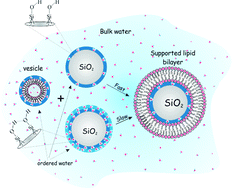Hydration repulsion effects on the formation of supported lipid bilayers
Abstract
When zwitterionic

* Corresponding authors
a
Department of Chemistry, Temple University, 1901 N 13th St, Beury Hall, Philadelphia, PA, USA
E-mail:
slwunder@temple,edu
b Department of Chemical Engineering, University of Rhode Island, 16 Greenhouse Road, Crawford Hall, Kingston, RI, USA
When zwitterionic

 Please wait while we load your content...
Something went wrong. Try again?
Please wait while we load your content...
Something went wrong. Try again?
S. Ahmed, R. R. Madathingal, S. L. Wunder, Y. Chen and G. Bothun, Soft Matter, 2011, 7, 1936 DOI: 10.1039/C0SM01045F
To request permission to reproduce material from this article, please go to the Copyright Clearance Center request page.
If you are an author contributing to an RSC publication, you do not need to request permission provided correct acknowledgement is given.
If you are the author of this article, you do not need to request permission to reproduce figures and diagrams provided correct acknowledgement is given. If you want to reproduce the whole article in a third-party publication (excluding your thesis/dissertation for which permission is not required) please go to the Copyright Clearance Center request page.
Read more about how to correctly acknowledge RSC content.
 Fetching data from CrossRef.
Fetching data from CrossRef.
This may take some time to load.
Loading related content
